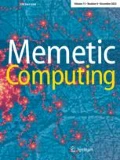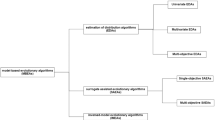Abstract
A novel direction-based multi-objective evolutionary algorithm (DMEA) is proposed, in which a population evolves over time along some directions of improvement. We distinguish two types of direction: (1) the convergence direction between a non-dominated solution (stored in an archive) and a dominated solution from the current population; and, (2) the spread direction between two non-dominated solutions in the archive. At each generation, these directions are used to perturb the current parental population from which offspring are produced. The combined population of offspring and archived solutions forms the basis for the creation of both the next-generation archive and parental pools. The rule governing the formation of the next-generation parental pool is as follows: the first half is populated by non-dominated solutions whose spread is aided by a niching criterion applied in the decision space. The second half is filled with both non-dominated and dominated solutions from the sorted remainder of the combined population. The selection of non-dominated solutions for the next-generation archive is also assisted by a mechanism, in which neighborhoods of rays in objective space serve as niches. These rays originate from the current estimate of the Pareto optimal front’s (POF’s) ideal point and emit randomly into the hyperquadrant that contains the current POF estimate. Experiments on two well-known benchmark sets, namely ZDT and DTLZ have been carried out to investigate the performance and the behavior of the DMEA. We validated its performance by comparing it with four well-known existing algorithms. With respect to convergence and spread performance, DMEA turns out to be very competitive.
Similar content being viewed by others
References
Abbass HA (2006) An economical cognitive approach for bi-objective optimization using bliss points, visualization, and interaction. Soft Comput 10(8): 687–698
Abbass HA, Sarker R, Newton C (2001) PDE: a Pareto frontier differential evolution approach for multiobjective optimization problems. In: Proceedings of the congress on evolutionary computation, IEEE Service Center, Seoul, Korea, vol 2, pp 971–978
Bleuler S, Laumanns M, Thiele L, Zitzler E (2003) Pisa: a platform and programming language independent interface for search algorithms. In: Evolutionary multi-criterion optimization. Lecture notes in computer science, vol 2632. Springer, Berlin, pp 494–508
Bui LT, Alam S (2008) Multi-objective optimization in computational intelligence: theory and practice. Information Science Reference Series: IGI Global, Hershey, USA
Bui LT, Abbass HA, Essam D (2009) Local models—an approach to distributed multi-objective optimization. Comput Optim Appl 42(1): 105–139
Caponio A, Neri F (2009) Integrating cross-dominance adaptation in multi-objective memetic algorithms. In: Goh C-K, Ong Y-S, Tan KC (eds) Multi-objective memetic algorithms. Studies in computational intelligence, vol 171. Springer, Berlin, pp 325–351
Coello CAC (2006) Evolutionary multi-objective optimization: a historical view of the field. IEEE Comput Intell Mag 1(1): 28–36
Coello CAC, Veldhuizen DAV, Lamont GB (2002) Evolutionary algorithms for solving multi-objective problems. Kluwer, New York
Coello CAC, Pulido GT, Lechuga MS (2004) Handling multiple objectives with particle swarm optimization. IEEE Trans Evol Comput 8(3): 256–279
Coello CAC, Lamont GB, Veldhuizen DAV (2007) Evolutionary algorithms for solving multi-objective problems. Springer, New York
Deb K (2001) Multiobjective optimization using evolutionary algorithms. Wiley, New York
Deb K, Thiele L, Laumanns M, Zitzler E (2001) Scalable test problems for evolutionary multi-objective optimization. TIK-Report no. 112. Tech. rep., Computer Engineering and Networks Laboratory (TIK), Swiss Federal Institute of Technology (ETH), Zurich
Deb K, Pratap A, Agarwal S, Meyarivan T (2002) A fast and elitist multiobjective genetic algorithm: NSGA-II. IEEE Trans Evol Comput 6(2): 182–197
DeJong KA (1975) An analysis of the behavior of a class of genetic adaptive systems. PhD thesis, University of Michigan, Ann Arbor
Díaz-Madron̈ero M, Peidro D, Mula J, Ferriols FJ (2009) Fuzzy multiobjective mathematical programming approaches for operational transport planning in an automobile supply chain. J Quant Methods Econ Bus Adm 9: 44–68
Goh CK, Teoh EJ, Tan KC (2008) Hybrid multiobjective evolutionary design for artificial neural networks. IEEE Trans Neural Netw 19(9): 1531–1548
Knowles J, Corne D (2000) Approximating the nondominated front using the Pareto archived evolution strategy. Evol Comput 8(2): 149–172
Kwan CM, Chang CS (2008) Timetable synchronization of mass rapid transit system using multiobjective evolutionary approach. IEEE Trans Syst Man Cybern Part C 38(5): 636–648
Lara A, Coello CAC, Schuetze O (2010) Using gradient information for multi-objective problems in the evolutionary context. In: GECCO’10, pp 2011–2014
Ong, YS, Tan, KC, Goh, C-K (eds) (2009) Multi-objective memetic algorithms. Studies in computational intelligence, vol 171. Springer, Berlin
Osman, IH, Kelly, JP (eds) (1996) Meta-heuristics: theory and applications. Kluwer, New York
Price K, Storn R, Lampinen J (2005) Differential evolution—a practical approach to global optimization. Springer, Berlin
Rudolph G, Agapie A (2000) Convergence properties of some multi-objective evolutionary algorithms. In: Proceedings of the congress on evolutionary computation. IEEE Press, New York, pp 1010–1016
Schaffer JD (1985) Multiple objective optimization with vector evaluated genetic algorithms. In: Genetic algorithms and their applications: proceedings of the first international conference on genettic algorithms, Hillsdale, New Jersey, pp 93–100
Shir OM, Bäck T (2009) Niching with derandomized evolution strategies in artificial and real-world landscapes. Nat Comput 8(1): 171–196
Shir OM, Preuss M, Naujoks B, Emmerich M (2009) Enhancing decision space diversity in evolutionary multiobjective algorithms. In: Matthias E et al (eds) Proceedings of the 5th international conference on evolutionary multi-criterion optimization, France, pp 95–109
Snyman JA (2005) Practical mathematical optimization: an introduction to basic optimization theory and classical and new gradient-based algorithms. Springer, Berlin
Storn R, Price K (1995) Differential evolution—a simple and efficient adaptive scheme for global optimization over continuous spaces. Technical report tr-95-012. Tech. rep., ICSI
Tan KC, Khor EF, Lee TH (2005) Multiobjective evolutionary algorithms and applications. Springer, Berlin
Tan KC, Chiam SC, Mamun AA, Goh CK (2009) Balancing exploration and exploitation with adaptive variation for evolutionary multi-objective optimization. Eur J Oper Res 197(2): 701–713
Veldhuizen DAV (1999) Multiobjective evolutionary algorithms: Classifications, analyses, and new innovation. PhD thesis, Department of Electrical Engineering and Computer Engineering, Air Force Institute of Technology, Ohio, USA
Zitzler E (1999) Evolutionary algorithms for multiobjective optimization: methods and applications. PhD thesis, Ph.D. dissertation, Swiss Federal Institute of Technology (ETH), Zurich, Switzerland
Zitzler E, Deb K, Thiele L (2000) Comparison of multiobjective evolutionary algorithms: empirical results. Evol Comput 8(2): 173–195
Zitzler E, Thiele L, Deb K (2000) Comparison of multiobjective evolutionary algorithms: empirical results. Evol Comput 8(1): 173–195
Zitzler E, Laumanns M, Thiele L (2001) SPEA2: improving the strength Pareto evolutionary algorithm for multiobjective optimization. In: Giannakoglou KC, Tsahalis DT, Periaux J, Papailiou KD, Fogarty T (eds) Evolutionary methods for design optimization and control with applications to industrial problems. International Center for Numerical Methods in Engineering (Cmine), pp 95–100
Author information
Authors and Affiliations
Corresponding author
Rights and permissions
About this article
Cite this article
Bui, L.T., Liu, J., Bender, A. et al. DMEA: a direction-based multiobjective evolutionary algorithm. Memetic Comp. 3, 271–285 (2011). https://doi.org/10.1007/s12293-011-0072-9
Received:
Accepted:
Published:
Issue Date:
DOI: https://doi.org/10.1007/s12293-011-0072-9




